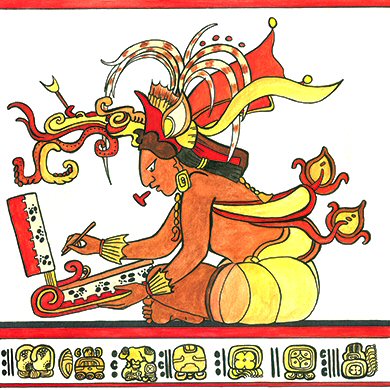March 16, 2016
 The Mayan Lesson
The Mayan Lesson
Human nature does not change; it only repeats itself. The ancient Maya, a singularly gifted civilization that peaked, declined and collapsed almost simultaneously with the Roman Empire, left a vast historical record. It is the tale of an unholy alliance of kings, priests, and military leaders who usurped and corrupted their religion to legitimize and perpetuate their rule. To subdue their people, they created a society afflicted with abysmal inequality, and used their wealth to wage perennial wars of aggression and flagrant genocide. In the process, they poisoned their ecosystem.
Collectively the Maya once managed to occupy and control the deltas of most Caribbean rivers in Mesoamerica, from the Pánuco River on the north, where the Teenek (or Huastec, as the Aztecs still call them) live, and the Gulf of Honduras. Whether they achieved this astonishing feat in pre-classical days –when they all spoke Proto-Mayan and under the command of a long-forgotten military genius- is anybody’s guess. The fact is, in a world without beasts of burden, pirogues reigned supreme as the only means of mass transit along the great rivers. And, by virtue of the strategic location of their homeland, they effectively controlled all fluvial and coastal trade between the highlands -with their vast deposits of obsidian, jade, cinnabar and many other minerals- and the Caribbean Sea. Over time, their immense wealth supported the great progress they made in so many fields of human endeavor, including, among many others, amazingly accurate calendars, linguistics (their glyphs were intelligible by speakers of all Mayan languages), mathematics, astronomy, hydrology, architecture, medicine (which made it possible for them to thrive in a jungle teeming with hundreds if not thousands of tropical diseases) and agriculture. Eventually the central authority splintered into a multitude of independent and competing city-states. Mirroring the long decline and demise of Latin, their rivalry and intentional mutual isolation eventually fractured Proto-Mayan into thirty-two related but mostly mutually-unintelligible languages -and the fratricidal wars began.
Lowly cinnabar, now all but forgotten, was, like oil in our time, a primary source of wealth -and power. It was used to make Mayan red for textiles, buildings, writing, pottery, murals and burials. The processes required industrial-scale refinement involving heat, usually in poorly ventilated huts or small rooms. One byproduct was pure elemental mercury, a highly toxic liquid metal that does not naturally exist in that state. As jars full of it have been found in ancient burial chambers, it may also have found its way to the food chain via aquifers, streams, rivers and the sea, an environmental catastrophe with incalculable consequences.
They also used cinnabar to coat cadavers with it, a necessity -or so they believed- since priests had long ago determined that only cinnabar would keep the dead from rising from their graves to steal the souls of the living. And the demand was incessant and permanent. The constant “flowery deaths” –cutting the beating hearts out of hapless captives- guaranteed a steady supply of cadavers. For the elite, it was a stupendously lucrative business. The kings, in cahoots with the priests and the generals, had a monopoly on war making, which caused deaths, and on cinnabar, which they imported from the highlands. That forced their subjects to work tirelessly for meager amounts of it by growing food, serving as citizen soldiers when their labor tending the fields was not required, or by collecting exotic feathers, jaguar skins, seashells, jade, or whatever the kings fancied at exchange rates the kings, not the people, determined.
The ruse lasted for centuries, possibly longer, until the day someone mustered the courage to verify it. And so, as it always eventually does, the truth surfaced. Ironically, their genial writing system -the Internet of the day, which had long since been usurped by the elite for their own purposes- may have played a pivotal role in the rebellion that followed.
Scores of barricaded temples and other structures have been unearthed where rulers, generals and priests took refuge as the vengeful, enraged masses came for them. The defenses did not hold; the elite were massacred, the scribes disappeared and the Classical Period came to an end. By A.D. 900 the great Cholan-speaking cities in the Petén jungle -along with the cult of intolerable inequality which had brought ordinary people so much misery and grief- had been abandoned. In their wake, truly egalitarian villages emerged, led by elders who doubled as custodians of a vestigial kernel of their ancient knowledge.
Nine hundred years later (letter to Colonel Charles Yancey, January 6, 1816) Thomas Jefferson aptly postulated what may be the underlying principle that destroyed the Mayan civilization -and now threatens our own: “If a nation expects to be ignorant and free, in a state of civilization, it expects what never was and never will be.”